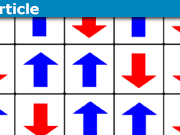Frequently Made Errors in Heat: Elementary Level
Table of Contents
1. Heat, Work, Internal Energy, and Kinetic Energy
“If heat is the motion of molecules, why isn’t it Kinetic Energy?”
In everyday use, we may think of a hot body as containing heat, but in Physics Heat and Work refer to the transfer of energy from one body to another.
Correspondingly, Internal Energy and Kinetic Energy refer to forms of energy possessed by a body.
Work and KE relate to mechanically useful energy, that is, the energy that can be used to propel bodies or raise them against gravity, etc.
Heat and Internal Energy relate to chaotic energy at the molecular level. This cannot so readily be employed to do useful work.
| Context | Macroscopic | Molecular |
|---|---|---|
| Energy Transfer | Work, W | Heat, Q |
| Energy Content (“state variable”) | KE, PE | Internal Energy, U |
But…
Consider two masses connected by a spring. The masses oscillate, but their common mass center is at rest. Viewed as ‘the system’, there is no KE but there is IE. But viewed as three separate systems – the two masses and the spring – there is KE and PE.
Energy may be stored in a system in many places and many ways. In a moving car, the body of the car has KE and PE. The rotating wheels have additional rotational KE, as do all the moving parts in the engine and transmission. The battery and fuel tank have chemical energy. Every molecule has additional KE as it jiggles and twists around, each dimension being a different energy state. Each of these modes can be considered a separate state in which energy can be stored.
Extracting useful work from a system grows more difficult as the energy content is spread across more internal states. Clearly, the molecular level energy states vastly outnumber the rest. Thus the term Internal Energy generally refers to the energy in these.
In the car example, there is a great gulf between the molecular scale and the macroscopic scales mentioned, so there’s little room for confusion. The situation is hazier for a wind powering a turbine. Turbines work best with steady airflows, where the overall motion of the entire body of air can be considered a single state. The energy in gusts is only apparent by considering smaller air parcels, so more states, and harder to utilize.
2. Wind Chill “Factor”
If the air temperature is 10C but the wind chill makes it -5C, why doesn’t the water freeze?
The wind chill is defined based on how the air temperature ‘feels’ to a human, as sensed by the surface temperature of the person’s skin. The body is continually giving off heat, and wind increases the rate at which cold air can carry away the heat from your skin. This causes the surface temperature of your skin to become lower. The wind chill temperature is the ambient air temperature at which still air would result in the same skin temperature as the actual ambient air temperature with the wind blowing.
An object left out in the breeze will come to the same temperature as the air. Once that has happened, there is no flow of heat, so the wind cannot make the heat flow faster.
If the air is hotter than your skin, a wind may make the air feel hotter still, but this may be countered by increased evaporation.
3. Thermal Equilibration and Phase Change
“Mass … of solid substance A at temperature … is placed alongside a flexible tank filled with mass … of gaseous substance B at temperature… Assume pressure remains constant. The system as a whole is insulated from the external world and allowed to come to thermal equilibrium. What is the eventual temperature of the system?” [Masses, initial temperatures, melting points, boiling points, latent heats, and specific heats all provided.]
Students may struggle with such a question because it is hard to guess in advance what the final physical states will be of the substances. The problem is not amenable to the usual physics procedure of writing down a few equations and solving them.
In the above example, there are four critical temperatures, the melting and boiling points of the two substances. In principle, the final temperature may be in any of the five ranges produced by those thresholds, or precisely at one of the four thresholds (with one of the substances present in two phases).
One approach, then, is to consider each of these nine possibilities, in turn, performing the calculation on each basis.
A smarter technique is to start in the middle, assuming all ends up as liquid. If the resulting temperature is higher than one of the boiling points then we can adjust the calculation on the basis of the substance with the lower boiling point partly or wholly evaporating. If the resulting temperature still exceeds the boiling point of the other, we shift up again. Similarly, if the resulting temperature from the initial attempt is below a freezing point, we adjust down.
Example:
| Property | Units | A | B | Symbols (X=A|B) |
|---|---|---|---|---|
| Mass | kg | 1.1 | 1.2 | |
| Initial temperature | C | -10 | 120 | |
| Initial state | SLG | S | G | |
| Specific heat as solid | J/kgC | 2000 | 2500 | |
| Melting point | C | 10 | 50 | |
| Latent heat of fusion | J/kg | 300000 | 200000 | |
| Specific heat as liquid | J/kgC | 4000 | 3000 | |
| Boiling point | C | 20 | 100 | |
| Latent heat of evaporation | J/kg | 150000 | 180000 | |
| Specific heat as gas | J/kgC | 1800 | 1500 |
Step 1: Assume all ends as liquid at temperature T
1.1*((10-(-10))*2000+300000+4000*(T-10C))J/C = 1.2*((120-100)*1800+180000+3000*(100C-T))J/C
T(1.2*3000+1.1*4000)J/C = -1.1*((10-(-10))*2000+300000+4000*(-10)) J + 1.2*((120-100)*1800+180000+3000*(100))J
T=36.5C
But this is below the melting point of substance B, so some or all of that must freeze. However, we do not need to start the calculation from scratch.
Step 2: Starting with this fictitious state of all being liquid at 36.5C, we let a mass M of substance B freeze. The latent heat released needs to warm everything back up to the melting point of B:
(50-36.5)*(1.1*4000+1.2*3000)J=M*200000J/kg
M=0.54kg
Since this is less than the total mass of substance B, we have our final state.
Masters in Mathematics. Interests: climate change & renewable energy; travel; cycling, bushwalking; mathematical puzzles and paradoxes, Azed crosswords, bridge








Excellent. Also one of the most made mistakes are ∫dQ and ∫dW not equal to ΔQ and ΔW They equal Q and W but ∫dU=ΔU.
Nice article!
Another great addition to the FME series!